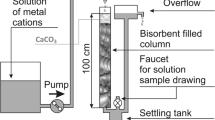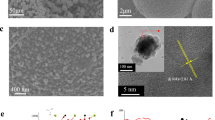Abstract
The interactions between soluble orthophosphates and lime (CaCO3) have been extensively studied because of the frequent occurrence of soil systems rich in CaCO3 and the dominant effect of calcium carbonate on phosphate solubility. Several investigators have suggested that in these systems chemically defined calcium phosphate species are precipitated. Cole and Olsen1 found that the solubility of phosphate in calcareous soils seems to be controlled by a di-calcium phosphate (DCP) solid phase, although the solubility product inferred (2.89 × 10−9) is significantly less than that measured2 for DCP (2 × 10×7). Similar results have been reported for the interaction between fish-pond sediments and the aqueous phase3. On the other hand, Stum and Leckie4 have suggested that the solubility of phosphate in calcareous systems may be controlled by the chem-isorption of phosphate on CaCO3 particles, with the formation of amorphous calcium phosphates3 or of surface complexes.4 We now describe experiments which argue for the formation of a surface complex of calcium-carbonate–phosphate with well defined chemical composition.
This is a preview of subscription content, access via your institution
Access options
Subscribe to this journal
Receive 51 print issues and online access
$199.00 per year
only $3.90 per issue
Buy this article
- Purchase on Springer Link
- Instant access to full article PDF
Prices may be subject to local taxes which are calculated during checkout
Similar content being viewed by others
References
Cole, C. V. & Olsen, S. R. Proc. Soil Sci. Soc. Am. 23, 116–118 (1959).
Gregory, T. M., Moreno, E. C. & Brown, W. E. J. Res. natn. Bur. Standards 74 A, 461–475 (1970).
Avnimelech, Y. Verh. int. Verein. Limnol. 19, 2305–2308 (1975).
Stumm, W. & Leckie, J. O. Proc. 5th int. Conf. on Advances in Water Pollution Research (Pergamon, Oxford, 1971).
Rootare, H. M., Deitz, V. R. & Carpenter, F. G. J. Colloid Sci. 17, 179–206 (1962).
Olsen, S. R. & Watanabe, J. S. Proc. Soil Sci. Soc. Am. 21, 144–149 (1975).
Rand, M. C., Greenberg, A. E. & Taras, M. T. (eds) Standard Methods for the Examination of Water and Wastewater 14th edn (American Public Health Association, Washington DC, 1976).
Nakayama, F. S. Soil Sci. 106, 429–434 (1968).
Gimblett, F. G. R. & Mohk, C. B. Trans. Faraday Soc. 50, 965–972 (1959).
MacGregor, J. & Brown, W. E. Nature 205, 359–361 (1965).
Grimshow, R. W. The Chemistry and Physics of Clays and Other Ceramic Materials (Benn, London, 1971).
Avnimelech, Y., Moreno, E. C. & Brown, W. E. J. Res. natn. Bur. Standards 77 A, 149–155 (1973).
Author information
Authors and Affiliations
Rights and permissions
About this article
Cite this article
Avnimelech, Y. Calcium-carbonate–phosphate surface complex in calcareous systems. Nature 288, 255–257 (1980). https://doi.org/10.1038/288255a0
Received:
Accepted:
Issue Date:
DOI: https://doi.org/10.1038/288255a0
This article is cited by
-
An Evaluation of Several In-Lake Restoration Techniques to Improve the Water Quality Problem (Eutrophication) of Saint-Augustin Lake, Quebec, Canada
Environmental Management (2012)
-
Mechanisms of Phosphorus Control in Urban Streams Receiving Sewage Effluent
Water, Air, and Soil Pollution (2008)
-
Phosphorus retention in calcareous soils and the effect of organic matter on its mobility
Geochemical Transactions (2006)
-
Orthophosphate solubility in waters of different ionic composition
Fertilizer Research (1995)
-
Phosphate and calcium carbonate saturation in a stratified coastal lagoon
Hydrobiologia (1992)
Comments
By submitting a comment you agree to abide by our Terms and Community Guidelines. If you find something abusive or that does not comply with our terms or guidelines please flag it as inappropriate.



